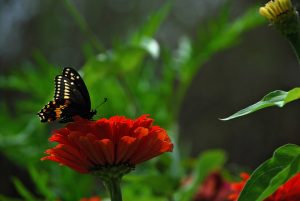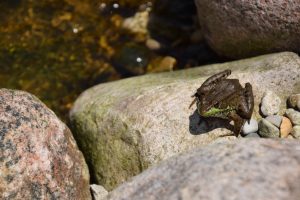Wildlife-friendly gardens add more enjoyment
By Nicole Flowers-Kimmerle University of Illinois Extension horticulture educator — April 19, 2020
Plants that flower early offer a food source for insect like butterflies as as they become active in the spring. (Photo courtesy of U of Illinois Extension)
Do you enjoy watching bees buzzing around your flowers, butterflies resting in the sun, or a fat toad sitting in a shady spot?
Making your garden wildlife-friendly starts with knowing what will attract birds, insects, and animals to your yard. Wildlife needs water, a food source, shelter, and space.
Small changes in your garden habitat can make a big difference to the wildlife you wish to attract.
One way to attract wildlife to your garden is to add a water source, like a birdbath. To maintain a healthy environment for your wildlife, be sure to clean your birdbath two to three times per week.
It’s important to thoroughly rinse away all cleaning products from the birdbath before refilling it with clean water and allowing animals to use it again. Birdbaths are not the only option, though.
A water source can be as simple as a rock with a depression that holds water.
Another thing to consider for a wildlife-friendly garden is a food source. When it is time for fall clean up, consider leaving seed heads on perennial plants, which can be a food source for birds. Leaf litter and hollow stems can provide overwintering sites for many beneficial insects and pollinators.
Plants that flower early offer a food source for those insects as they become active in the spring. Make sure that your garden includes a variety of plants, so that there are blooms from early spring to late fall.
Increase the variety of butterflies by providing food for their larvae. Plants from the carrot and aster families are great options. Plant extra dill or parsley, and you may see more swallowtail butterflies in your garden.
It’s important to remember that as you provide an attractive habitat for wildlife, pests may also find your garden. Not to fear, though — insect predators and parasites, attracted to the variety you’ve created, will move in and help control those pests.

Toads are another creature that will help control insect pests. (Photo courtesy of U of Illinois Extension)
Insect-eating birds will find their way to your garden if their preferred food becomes more abundant.
Some organic farms even include birds as part of their pest management plan. Keep in mind that there will be a lag time between the pests showing up and the beneficial creatures doing their job to decrease the population.
Just be patient and trust that they will take care of those pests for you in due time.
Shelter is the third important component of a wildlife-friendly garden. Provide shrubs and trees that vary in height for housing all types of animals. Consider creating a toad house by turning over a terra cotta pot and propping up one side to create an entrance.
Toads are another creature that will help control insect pests.
Finally, sit back and enjoy the wildlife that is visiting your garden. Recording your observations in a nature journal is a fun way to spend time in your garden with the added bonus of helping you track how your garden and its wildlife inhabitants change from year to year.
Additional articles like this are available in University of Illinois Extension Gardener’s Corner Spring edition at https://extension.illinois.edu/global/gardeners-corner
Nicole Flowers-Kimmerle, University of Illinois Extension horticulture educator, serves Fulton, Mason, Peoria, and Tazewell Counties. Find more information online at https://extension.illinois.edu/fmpt.
Ad 1 – 300×250 – Google ROS
Trending News
 Pritzker signs executive order responding ...SPRINGFIELD — Gov. J.B. Pritzker signed an executive order July 14 requiring ...
Pritzker signs executive order responding ...SPRINGFIELD — Gov. J.B. Pritzker signed an executive order July 14 requiring ... Democratic primary in 9th Congressional ...The ever-growing candidate field for Illinois' 9th Congressional Democratic primary isn’t a ...
Democratic primary in 9th Congressional ...The ever-growing candidate field for Illinois' 9th Congressional Democratic primary isn’t a ... Chicago West Side workforce development ...As Aspire Center for Workforce Innovation, the new workforce development and social ...
Chicago West Side workforce development ...As Aspire Center for Workforce Innovation, the new workforce development and social ... Pace makes service improvements in ...Pace board of directors voted unanimously on July 16 to make the ...
Pace makes service improvements in ...Pace board of directors voted unanimously on July 16 to make the ...
Ad 3 – 300×600 – Post Pages – Google ROS
Ad 2 – 300×250 – Google ROS



